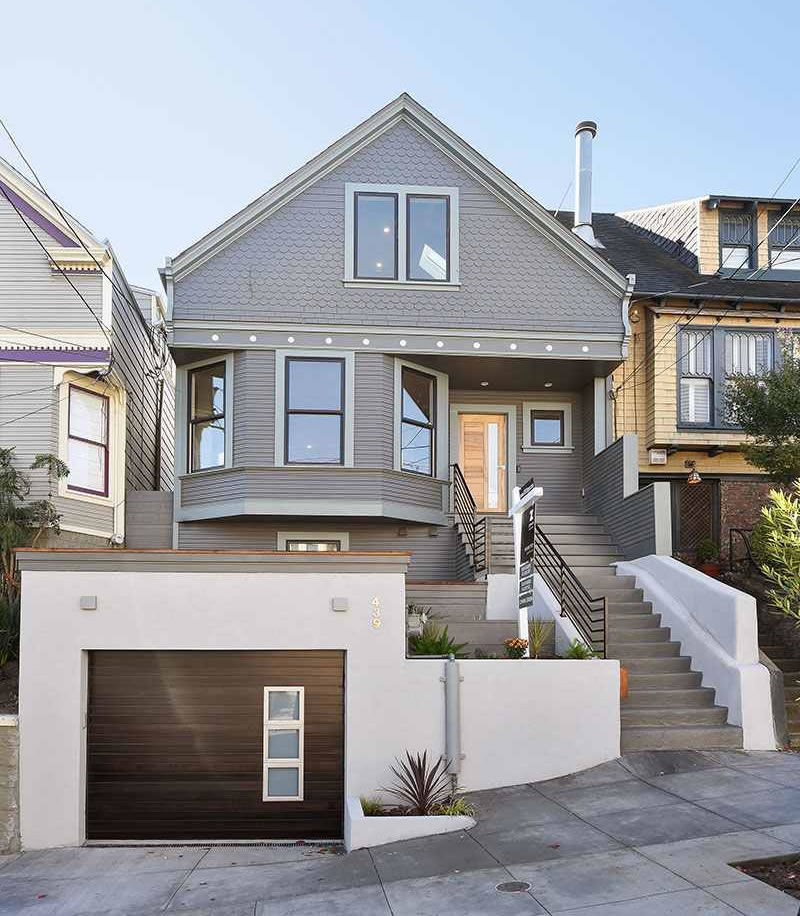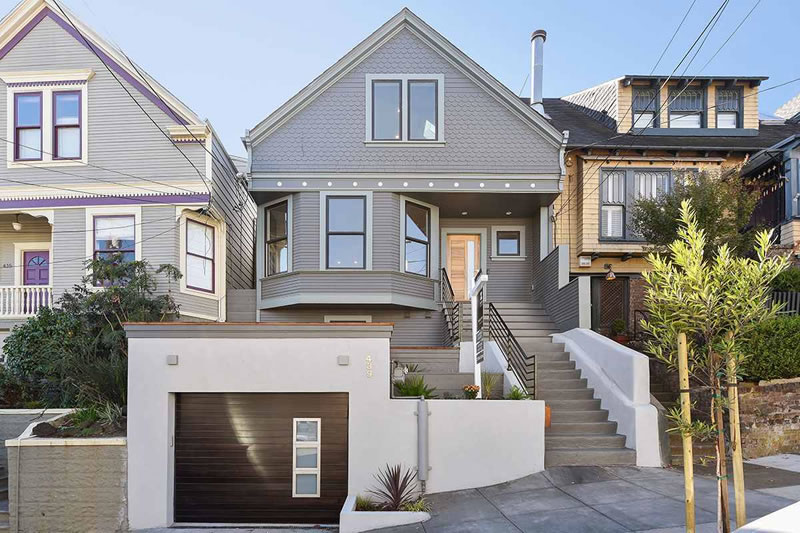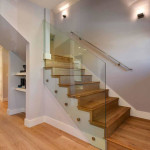Listed for $3.55 million last October, the asking price for the completely remodeled Noe Valley home at 439 Clipper Street was subsequently reduced to $3.25 million, at which point the listing was updated to tout the ‘best priced home in Noe Valley’ and to warn that the ‘seller [would be] moving-in in January 2016 if not sold.’
Withdrawn from the MLS in December, the ‘spectacular,’ and still unoccupied, Victorian was re-listed this morning for $2.995 million, and with an official ‘one’ day on the market, and zero reductions, according to industry stats and local reports.










So they paid 850K for it originally in ’08, and spent what, $1mm on improvements?
Now everyone come the snarky comments about a reduced offering price while the sellers print 750K-1mm in profits? Could be worse.
[Some quibbler with holding cost complaints etc. in 3,2,1…]
Who are you soccermom? How do you consistently manage to be one of the relatively few voices of reason on SocketSite?
Well, I got hit by a car about two years ago, and it did a number on my rear left leg. The scar started to bother me a couple of months ago, and now my owner has me wearing one of those embarrassing “no-chew” plastic cones around my neck. A lot of people thought that a three-legged dachshund couldn’t keep up a good internet comment game, but I’ve figured out how to type with both front paws on the laptop when no one’s looking. Oh wait – shh- I hear someone at the door…
She’s had some zingers. But harping on holding costs for an 8 year vacant hold, especially with the ‘We’re really really gonna move in now’ empty threat, falls far far from the mark.
And the price reduction and lack of bidding war in Noe of all places is quite the tidbit in and of itself.
Well, after 8 years the holding costs are much more than a quibble.
I agree that a sale at the new asking would be a perfectly fine result. However, with 8 years of holding costs and property taxes, selling costs, and transfer taxes (and capital gains taxes), the result is certainly well short of spectacular. They may have done better, with way fewer headaches, with a simple S&P index fund. Now, I’m assuming from the “unoccupied” note in the entry that they never lived in the place. If they did live here, the result is much better.
For comparison, our neighbors bought their place in late 2013 and just sold it for a $500,000 gain (~ 35% in two years on a leveraged buy), and they lived in the place. Now that is a nice outcome. The long, long holding time for this Clipper place really removes it from the “great deal” category. So, yes, “could be worse.” But it’s not too tough to realize about a 5% annual gain, which doesn’t sound nearly as impressive as 750k-1mm. This result is nothing to write home about.
I knew I could count on you.
Heck, you should have just done the math yourself instead of making me do it! I bill by the hour . . .
Except you haven’t done the math. You just said a bunch of stuff.
5% annual return . . .
This really wasn’t the best example to criticize “quibblers” about holding costs.
How do you arrive at 5%? Please show your work.
What assumptions for borrowing costs, leverage, property construction costs, transaction costs? These values are germane to your 5% stated outcome.
Please include the timing of the construction.
If you want to consider the tax implications, please state whether the sellers will execute a 1031 exchange.
Please note that 1031 exchanges are not available to your S&P 500 comparison.
1031 exchanges are also not available to homeowners.
Please state your estimate of the contribution of the payoff on the investor’s overall capital market portfolio. Vs. the S&P? What if they are already long $10mm in the S&P. Did this investment project diversify the outcome under the CAPM model?
What was the expected risk/return variance for the project? Do you think this is at the efficient frontier of the capital markets?
Do any of these things matter in your investment portfolio?
What contribution to the developer’s ongoing business did the work provided to the contractor mean?
Will he/she get better treatment if this represented new or repeat business?
Do these things matter in a big flip project?
What about the marginal use of the developer’s time?
What else would he/she have been doing if not working on this project?
Whether or not they execute a 1031 exchange, what is your estimate of future capital gains tax policy?
Will tax rates rise? Fall?
When?
By how much?
Well, if you are looking for an analysis that is based on all those factors, including whether tax rates will rise or fall, I’m afraid I can’t offer you any help. I’m just an M&A lawyer. You might be better off consulting a crystallomancer.
Fair enough. Just saying stuff is a lot easier. For people who invest professionally in real estate and capital markets, all of these things matter.
Excellent – I look forward to your providing your thoughts on these points. I always look forward to your comments as a cut above the all-too-typical ad hominen attacks or knee-jerk criticisms.
“Excellent – I look forward to your providing your thoughts on these points. I always look forward to your comments as a cut above the all-too-typical ad hominen attacks or knee-jerk criticisms.”
It seems as if your initial 8 years holding costs post, with its 5% annual gain takeaway, was very much a knee jerk criticism.
“It seems as if your initial 8 years holding costs post, with its 5% annual gain takeaway, was very much a knee jerk criticism.”
Dismissing holding/opportunity costs for an 8 year hold during a time period where the S&P was up 40+% (more even if you include dividend re-investment) is a knee jerk reaction as well. But more importantly, knee jerk or not, is it right to dismiss this?
It’s one thing to make the argument that ‘Common sense would tell you X, but my detailed calculations show Y’, but she hasn’t actually done the detailed calculations to show anything.
I think making estimates of Internal Rates of Return is a perilous exercise with this many variables, hence I limited my analysis to (Sales Price – (Cost + Cap Ex)) = @$750K-1mm, which “Could be worse.”
I believe I am alone in frequently offering estimated P&L calculations in this comment section.
My original point was that we get snarky about real estate agents with priced priced too low, and we get snarky with real estate agents with prices too high. “Whatever,” I suppose. Agents keep taking 5-6% out of the trade and they can probably stomach the dog/agent comparisons people seem willing to sprinkle down from on high.
There is more to it than that. The problem is that (Sales Price – (Cost + Cap Ex)) = @$750K-1mm does not provide anything meaningful, at best, and is outright misleading at worst. (esp. when the “Cap Ex” number was just a wild guess).
A more extreme example illustrates this point. One buys a place for $10mm, puts $1mm in renovations, and then sells 8 years later for $12mm. One could say that (Sales Price – (Cost + Cap Ex)) = printing 1mm in profits(!!!). But that, of course, would be incomplete and inaccurate. There are also the details of all the other costs that are left out – property taxes for 8 years, buying costs, selling costs, insurance, maintenance, transfer taxes. And even if those were all $0, a 10% gain after 8 years is pretty unimpressive, just a little better than 1% a year.
Here, we simply don’t know all those holding costs. Nor do we know what was financed or at what rate. So all we can do is make some assumptions and use some shorthand (and then, of course, anyone can criticize those assumptions and shorthand – easiest thing in the world to do). But the one thing that is not fair at all is to simply dismiss all those real costs as an insignificant quibble.
Great. No one else is capable of doing the math, so here goes:
Year 0: Put in 200K equity and borrow 650K
Years 1-6: Pay 35Kper year in holding costs
Year 7: Put in 300K in construction costs and borrow 400K more, pay 335K (700K) Construction budget.
Year 8: Net $2,850K, pay off 1,050K in debt, to receive 1,800K back.
This is roughly equivalent to a 20.45% IRR, quibblers.
$700,000 in construction costs? Dream on. It may be shoddy, but not that shoddy. And you forgot transaction costs and transfer taxes. And this new math isn’t consistent with your first post.
Updated for you, random anon-entity:
Year 0: Put in 200K equity and borrow 650K
Years 1-6: Pay 35Kper year in holding costs
Year 7: Put in 300K in construction costs and borrow 700K more, pay 335K (1mm) Construction budget.
Year 8: Net $2,750K, pay off 1,250K in debt, to receive 1,500K back.
This is roughly equivalent to a 16.49% IRR. Good or bad trade? I’ll take 16.5% compounded any day of the week.
Maybe Greg Fulford can chime in with more details. He’s listed a lot of these ‘Property Brothers’ Vanguard flips in the Richmond. Maybe they are all from the same seller.
Who knows if they can sell it. As I recall, this is the house with the door-to-nowhere off the kitchen, which is a very weird choice IMHO. I think they would be better served to frame in a tall operable window and enclose the space.
All just, guessing, which is the problem. But accepting your guesses
You were off by $100,000 on the loan repayment
You forgot transaction costs and transfer taxes of about $180,000
Holding costs go up when you double the loan amount, about another $70,000
Returns look much better if you ignore major costs.
LOOK HOW FAR I HAVE FALLEN INTO THE TRAP I HAVE SET FOR MYSELF:
Updated for you, random anon-entity:
Year 0: Put in 200K equity and borrow 650K
Years 1-6: Pay 35Kper year in holding costs
Year 7: Put in 300K in construction costs and borrow 700K more, pay 335K (1mm) Construction budget.
Year 8: Net $2,750K, pay off 1,350K in debt, to receive 1,400K back.
Net Proceeds of 2,750 is 93%of a $2,950 Sale Price, so I am incoporating 200K of transaction / closing transfer costs.
15% IRR here. “Could be worse” Like by investing in an S&P index fund:
House was purchased Feb 2008. CAGR for the S&P500 with dividends reinvested from Feb 2008 to present is roughly 6.6%
http://dqydj.net/sp-500-return-calculator/
Please, I’m here today to update a spreadsheet for anyone unable to do so herself. What else?
Apples to oranges. In addition to just guessing on your numbers, you’re comparing a leveraged real estate investment with an un-leveraged stock market investment. May as well assume they put $0 down and had an infinite return.
I DIDN’T START THE S&P 500 COMPARISON BUT I DARN WELL PLAN TO FINISH IT!!!
You can lever your SPY holdings too, by the way I just didn’t want to include that because then you would have to include the margin call/forced sale when the index fell 40% between Feb 08 and March 09. Makes the house look even better…
You’ve gone from a 20.45% IRR to 16.5% to 15%. All still with aggressive leverage assumptions. More than 25% at risk from the owner and soon you’ll be into the mid single digits. Printing less and less as we work through reality.
You’re right. My estimate is still 1000 basis points over Bob’s 5% estimate and 840 basis points over the equivalent S&P500 period return… Sounds like an investment I would try to make.
Don’t kid yourself. What you gave was not an estimate. You just made up numbers that give a pretty good hypothetical result.
Those numbers seem OK, anon. What is your problem with them?
The alternative was to rent. That holding cost has been way worse in SF.
I don’t get the 8 year hold. In that sense I assume this was an investment and 5%/year over 8 years could have been matched in the market.
Its a different world if one intended to live there. 5% is a reasonable appreciation rate for homes. its actually a bit higher than average.
SF is unique and the 35% two year gain your neighbor experienced was their luck and not a sustainable level of appreciation over time. Was it an investment?
A neighbor of mine moved in in 2013. Bought the home as a home to live in. Wife became pregnant with twins last year and they wanted to move to a larger home with a yard and a more kid-friendly city. They sold at the right time. Gaining 25% in 2 years. And were able to buy a nice place in Lafayette..
Our friends also moved to the burbs after having one baby during that 2-year period with another on the way. The age-old SF story – moved away when kids entered the picture so they could have a lawn, two-car garage, and better public schools.
That big gain for them was just a complete windfall. They didn’t anticipate it when they bought in 2013, and they didn’t expect that much when they sold.
And I agree that 5% appreciation a year on a home you live in is just fine. But certainly nothing to write home about after all the taxes and selling costs.
“random anon-entity”
Just to be clear, this new vintage anon of two hours ago is not I.
Though I have no complaints about people hammering out more accurate numbers.
I being anon of 22 hours ago, and I meant to respond to the thread above.
I get the tingles when people writing with anon handles try to differentiate themselves.
That’s next-level quibbling
I only really stepped in because I felt he/she was being a little to prickly towards you.
I suppose the whole point of being ‘anon’ is that what really matters is the content, not who’s saying it. And after all, it’s not as if your legal name is ‘soccermom’? The difference between anonymity and pseudonymity is slight in my book.
Interior design courtesy of the Property Brothers. (yawn)
as if the last agents were at fault and not the sellers. funny they went with vanguard, self-fulfilling prophecy.
The Vanguard people seem to have a pretty good playbook down for their flips. There seems to be a similarity of finish choices for their projects. This house has the same front door as the Clipper House, for example.
It will be interesting to see if they get close to list to the house on 24th Ave. Property Brothers, sure, but people keep buying them…
Not as cool as sparky-b’s artisanal front door.
Please point me to a photo of sparky-b’s artisanal door. I’m not disputing – I just don’t know what you mean…
Something to do with cheese, I suspect.
If you pay full price do they throw in the special brush you need to clean between the glass stair rail and the wall?
Maybe the wood steps butt up directly the glass? Seal with a little clear caulking and yer good. No?
I just love how threats (warnings) from the seller is a desperate attempt to tell some over moneyed buyer to get this Ikea inspired home before it’s too late. It’s like selling a cheap handbag on QVC: “Only 17 remaining.”
And I can’t wait to see who’s the first one to fall on that friendly, sharp edged glass handrail in the entry. Will it be the housewife stumbling home from Novy after 6 glasses of wine in the afternoon, or will it be the Dowager Countess as she trips on her cane?
Really good architecture has this effect.
any of you guys realize yet that this was not an 8 yr hold, it sold in 2014 with approved plans
There’s nothing at the assesor’s office that shows that. Link or it didn’t happen
I really like it. Those staged bar stool chairs though lol, I’ve seen them endless times in properly pix on here.
It was for sure listed in 2014, checked it out then, decided to pass on it, not sure if it sold
This description from the listing is hilarious: “Magnificent Master Bedroom…Three additional guest bedrooms” San Francisco has just given up on families living here, even wealthy ones that can afford $3M houses.
It seems to be a thing on some of the real estate TV shows. After discussing a master bedroom, why they have to modify “bedroom” with anything to describe the remaining bedrooms escapes me.
Garage door, front door, some interior finishes don’t work with the facade. Bad design.
Since being re-listed, they also have updated their marketing material.
UPDATE: The sale of 439 Clipper has closed escrow with a reported contact price of $3.3 million.